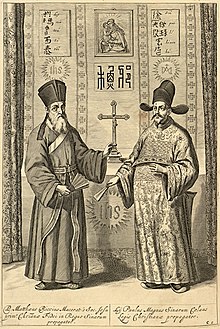
Back الرومانية الكاثوليكية في الصين Arabic Çində roman katolisizm Azerbaijani Katolická církev v Číně Czech Römisch-katholische Kirche in China German Iglesia católica en China Spanish Église catholique en Chine French Gereja Katolik di Tiongkok ID Chiesa cattolica in Cina Italian 중국의 로마 가톨릭교회 Korean Katholicisme in China Dutch

| Part of a series on the |
| Catholic Church by country |
|---|
 |
|
|
The Catholic Church in China (called Tiānzhǔ Jiào, 天主教, literally "Religion of the Lord of Heaven" after the Chinese term for the Christian God) has a long and complicated history. John of Montecorvino was the first Catholic missionary to reach China proper and first bishop of Khanbaliq during the Yuan dynasty (1271–1368).[1]
After the 1949 takeover by the Chinese Communist Party (CCP), Catholic and Protestant missionaries were expelled from the country. In 1957, the communist government established the Catholic Patriotic Association in Beijing,[2] which rejects the authority of the Holy See and appoints its own preferential bishops. Since September 2018, however, an agreement was reached, giving the Pope the power to veto any bishop which the Chinese government recommends.[3][4] However, the Church has claimed this agreement was breached in November 2022 and July 2023 when two bishops were installed without prior approval or consultation by the Vatican.[5]
- ^ "Giovanni da Montecorvino: Franciscan missionary". Encyclopædia Britannica. Chicago: Encyclopædia Britannica, Inc. 1 January 2022. Retrieved 21 August 2022.
- ^ Edmond Tang; Jean-Paul Weist (17 May 2013). The Catholic Church in Modern China: Perspectives. Wipf and Stock Publishers. pp. 13ff. ISBN 978-1-62564-086-4.
- ^ "Vatican and China sign agreement on bishop appointments". The Guardian. Reuters. 22 September 2018. Retrieved 23 September 2018.
- ^ Rocca, Francis X.; Dou, Eva (14 September 2018). "China and Vatican to Sign Landmark Deal Over Bishops". Wall Street Journal. ISSN 0099-9660. Retrieved 3 October 2018.
- ^ Pullella, Philip (15 July 2023). "Pope approves Shanghai bishop as Vatican chides China for lack of consultation". Reuters. Retrieved 15 July 2023.
© MMXXIII Rich X Search. We shall prevail. All rights reserved. Rich X Search